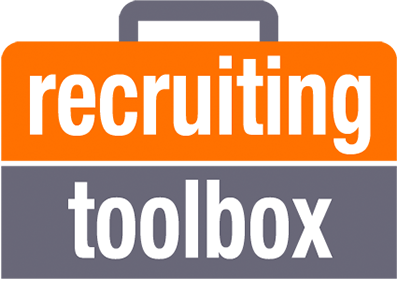Recruiting Toolbox Blog
Nine Ways to Become a Strategic Talent Advisor to Your Business
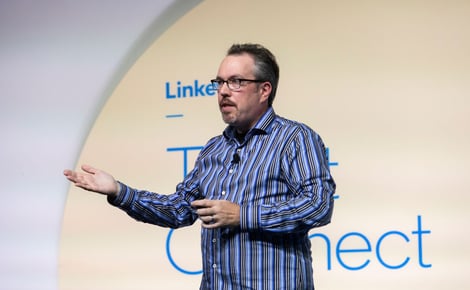
[This blog post first appeared on the LinkedIn Talent Blog, authored by Samantha McLaren, in December 2019.]
The Future of Recruiting Report found that 82% of recruiting professionals believe advising business leaders will become more important over the next five years. But in order to earn a recurring seat at the table and play a role as a trusted advisor to the business, you’ll need to demonstrate your strategic prowess on a day-to-day basis.
“Just calling yourself a talent advisor does not mean hiring managers are going to invite you in to talent advise them,” says John Vlastelica, founder and managing director of Recruiting Toolbox, a training and consulting firm. “And just because you got promoted to manager doesn't mean you are now instantly strategic.”
John points out that most recruiting professionals he talks to would like to be more strategic — and most hiring managers want more strategy from them. The problem is that there’s a fundamental disconnect about what “strategic” actually means, which is holding many teams back from seizing this opportunity.
“From talking to thousands of hiring managers and business executives… I can tell you what they want,” John says. “They want things that deliver speed, quality, and diversity — and if what you are doing is in service to speed, quality, and diversity, you are being strategic.”
During his top-rated talk at Talent Connect 2019, John shared nine steps you can take to make your role more strategic. These tips have worked for him and his clients, and they can help you deliver more strategic value to your business and allow you to show up as a talent advisor to your hiring managers and leaders.
1. Get your hiring managers involved in pre-funnel work to make great candidates more aware of your company
When it comes to sourcing candidates, John says every hiring manager he’s ever met talks about creating candidate pipelines, which they view solely as the recruiters’ responsibility. But he argues that hiring managers could be doing a lot more to get candidates into the funnel in the first place — and recruiters should be driving those efforts.
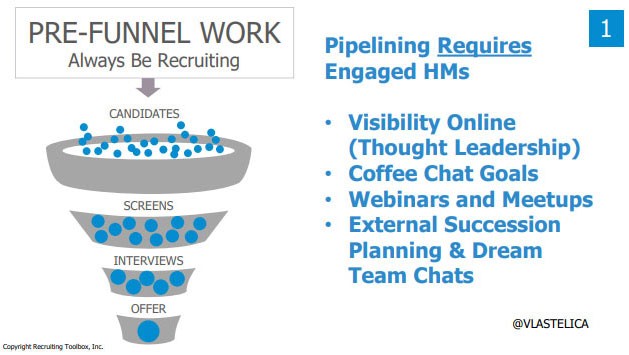
One way to do this is to encourage your hiring managers to become thought leaders online. They can do this by creating professional social media accounts and sharing content that’s relevant to the kind of hard-to-find candidates you want to hire. If you were looking to hire more female engineers, for example, your hiring manager might share insights from a panel discussion they attended about women in tech. In doing so, the manager is more likely to appear on a prospective candidate’s radar — putting your company on their radar too.
To ensure they have the resources and support they need, Autodesk, one of John’s clients, even dedicates a few hours during interview training solely to showing hiring managers how to build this compelling online presence.
“They're trying to teach them how to engage with the communities where we need to be farming, we need to be planting seeds,” John says. “Getting your hiring managers to be more visible in the communities you want to recruit from — that is key to great pipelining.”
Another tactic used by one of John’s former employees is setting “coffee chat” goals for hiring managers. The company gives them a gift card for a coffee shop and tasks them with meeting a certain number of promising candidates who aren’t actively looking for a job. But the manager’s role isn’t to convince these candidates to come work for the company — it’s just to talk to them, and to listen.
“You're having a conversation around what they like to do, what projects they're working on,” John says. “You slip in, where appropriate, conversations about the interesting problems and challenges and work you're doing…. This is pre-funnel work.”
Pre-funnel work is all about building awareness — getting the people you’re really interested in hiring thinking seriously about becoming candidates. Some of these efforts may only pay off months or even years down the line, and that’s fine. The goal is to “always be recruiting” and to instill that same mentality in your hiring managers. And when you start seeing results, you can share them internally to get others on board.
“Focus on the [hiring managers] that are willing to engage,” John says. “Start there and kind of build your reputation. Build the ROI story so you can get other people that aren't interested to do this.”
2. For high-volume roles, analyze whether most hires are internal or external and focus on the most useful source
While some hard-to-fill roles demand extensive pipeline efforts and a lot of hard work from you and your hiring managers, other roles may be easy to fill internally. And unless you’re paying attention to your source of hire, you may be wasting valuable time and resources by focusing on sources that don’t pay off.
Another of John’s clients, Sodexo, a food services and facilities management company, discovered this when it analyzed the most common sources for some of its high-volume roles. For one job category, the company found that 90% of hires were internal. Despite this, recruiters were spending a disproportionate amount of time talking to external candidates, which was time they could have applied to roles that actually required more outbound-sourcing work.
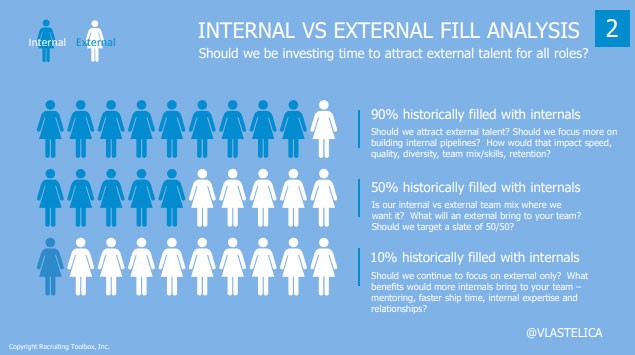
To help you identify where you could most strategically allocate your resources, John recommends looking at any roles that your recruiting team spends a lot of time on and identifying the breakdown of internal to external hires.
“Then ask, is that what you want?” he says. “Is that a good thing? Maybe you want… more external [candidates] for diversity… But have a conversation with the VP or the department leader and say, ‘What should our mix be?’”
3. Get greater buy-in from hiring managers by reducing time to fill and putting hours back in their day
Getting managers engaged and actively involved in your recruiting efforts can sometimes be difficult. If they’re already busy, they won’t be happy if they feel like you’re giving them extra work. John recommends phrasing your requests more strategically — by identifying their biggest pain points and offering them practical solutions.
“We ask the business, ‘How much is it costing you to have this job open another 60 days?’” John says. “And then you say, ‘Well, would you like to hear what some of the other hiring managers I'm working with are doing to get that kind of talent filled 30 days faster?’” And that’s music to their ears, according to John, since of course hiring managers want to go faster. With their interest piqued, they’ll then ask you for your insights — and that's how you can get invited in as a talent advisor.
And to reduce time to fill, it helps to know where you’re spending the most time. At Adidas’s headquarters in Germany, John says the recruiting team uses its applicant tracking system (ATS) to not only analyze how long the company spent on average at each stage of the hiring process, but also in comparison to other departments and the company averages. If there’s a lot of variation, the team can find out why certain people or departments are taking longer than others to complete that step.
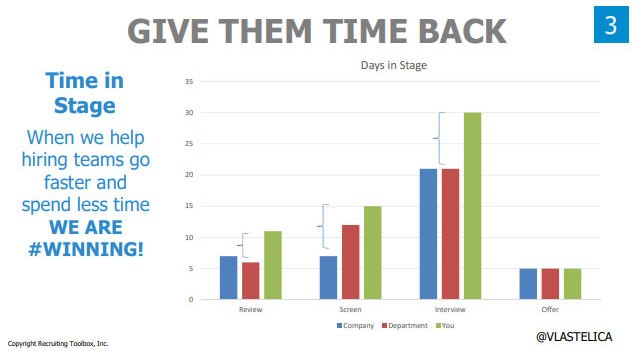
"It's really interesting when companies do this,” John says, “because you can actually see where some of the problems are... and you can have a really great talent advisor conversation about that gap.”
Another time-saving strategy that some of Recruiting Toolbox’s clients are using, including Disney and Northrop Grumman, is to test whether the hiring manager actually needs to be involved in phone screening for certain roles. For some higher volume roles, the recruiter is so calibrated to the hiring criteria and so on target with candidate recommendations that the hiring manager screen is unnecessary. As a result, the recruiter is trusted to schedule quality candidates directly on the hiring manager’s calendar for the onsite interview. This not only frees up countless hours of the hiring managers’ time, which can allow them to focus on pre-funnel work, but can also help you cut down on the back-and-forth and time spent scheduling interviews.
“Wouldn't that be awesome?” John enthuses. “We would be so strategic in the minds of business leaders if we could cut five or 10 days out of our time to fill.”
On the day of the interview itself, you can save more time by limiting the number of interviewers. This is another great opportunity to prove yourself as a trusted advisor. Rather than just asking the hiring manager who should be involved, have a strategic discussion about who actually needs to be involved. If they push back, show them how much longer it will take to bring more people in, and explain that more people doesn’t necessarily mean a better decision.
“Be smart around who needs to be involved,” John says. He suggests framing these discussions around optimizing for a quality hiring decision. Too many interviewers often leads to false negatives — those times where you say no to someone you should have said yes to.
4. Give candidates from all backgrounds access to the information they need to be successful
Looking back on his early career as a recruiter, John wishes he’d done more to help candidates be successful during interviews. While he’d spent years working at major companies like Amazon, some candidates had never worked for a tech company before or had no experience with U.S. business customs. He shouldn’t have expected them to come in knowing all the ropes.
“If you are really focused on diversity,” John says, “or you're focused on reaching out to people that maybe don't have experience interviewing in a company like yours... it's really, really important you spend a little time thinking not just about the candidate experience generically, but also, how can I set them up for success?”
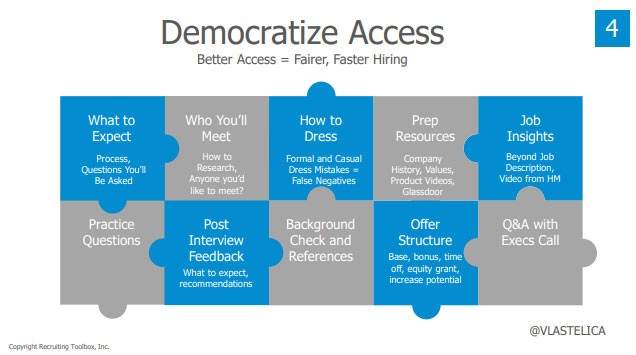
John points to Google as an example of a company that’s nailing this. Google’s career site outlines how the company’s interview process works and how candidates can best prepare.
“You should have something like that on your career site,” John says. “Take the initiative and just put something out there. Maybe talk to your boss and legal first, depending on what you write — but generally, you should just take the initiative and ask for forgiveness.”
Gaming company Electronic Arts takes this a step further. When the recruiting team is scheduling a candidate’s interview, they ask, “Is there anyone you'd like to meet from one of our employee resource groups?”
This is especially meaningful for candidates from underrepresented groups. By meeting a fellow working mom or another member of the LGBTQ+ community and discussing their experiences, the candidate can ask questions that the recruiting team might have been unable to answer — and make a more informed decision about the job.
You can also take a leaf out of Uber’s book and ask finalist candidates to submit questions ahead of the offer stage. Uber’s recruiting team looks at what kind of questions and concerns are coming up frequently and sets up group calls so candidates can chat with a senior member of staff. This not only gives finalist candidates a safe place to get big questions addressed directly by business leaders, but also helps Uber close top talent.
“It's just another way to give access to people that might not feel comfortable asking… in an interview situation,” John says. “How much would that cost for you to do? A little bit of influencing, but really no money to do something like that.”
Democratizing access to information isn’t just important for external hires. Being a strategic talent advisor is also about ensuring all your employees have equal opportunities to advance their carers at your company.
“One of the strategic things you could do is get some of your underrepresented folks that have had successful careers to teach other folks in your company,” John says. “Make it open to everybody, teach them how to get promoted in your company. Sometimes that stuff is based on unwritten rules. Wouldn't it be great if you brought some transparency to that?”
5. Be proactive by advising your leaders to open reqs early for high-turnover roles
When you think about your time to hire, the clock probably starts ticking for you the moment a req is approved. But John argues that for your hiring manager, it starts a lot sooner — like the moment someone resigns.
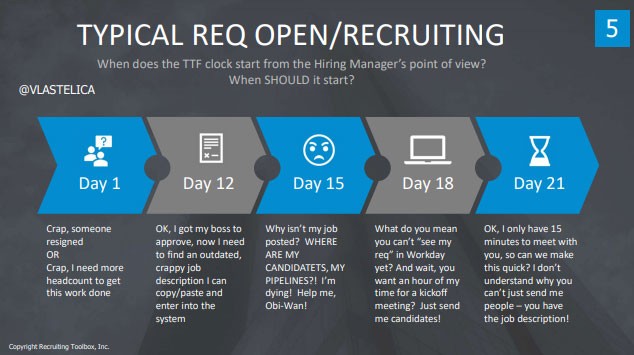
You can approach this situation more strategically and earn your hiring manager’s respect by predicting attrition and opening reqs early. One way to do this is by looking at your historical data. If a job category has a 20% turnover rate, for example, and most employees leave in November, you could advise business leaders to be proactive and get a headstart on hiring their replacements by opening the reqs months ahead of time. This was something that John’s Recruiting Toolbox colleague, Matt Grove, did while he was a recruiting director at KPMG.
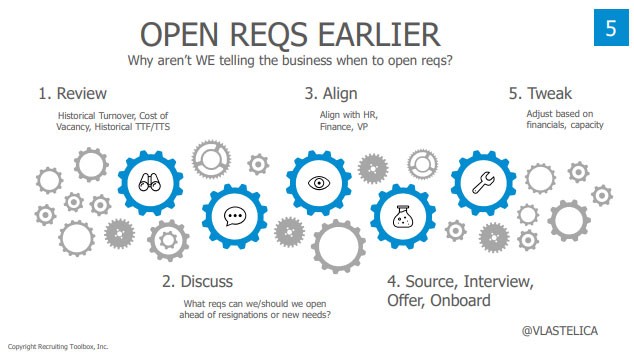
“[There are] huge opportunities for us to be strategic by not asking the business, ‘Can you open these reqs?’” John says, “but telling them, ‘You need to open these reqs now in September if you want these jobs filled by December 1st.’ Don't come to me December 1st and tell me you want them filled by the end of the year. Tell me now — or don't even tell me. I'm telling you.”
6. Streamline hiring for high-volume roles by scheduling batch interview days
For particularly high-volume roles, bringing candidates in to interview individually can be a scheduling headache. When John was at Amazon, he got around this by pre-scheduling batch interview days even before the team had candidates lined up.
“The idea was… let's have dedicated sourcers or recruiters whose job it is to fill 12 interviewing slots on every one of these days,” he explains. “And let's invite two different teams to compete/collaborate to hire the best people.”
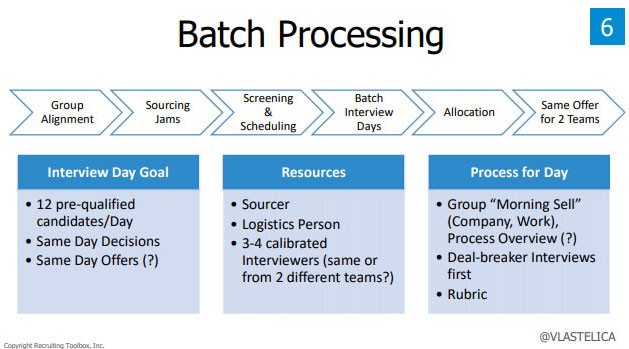
By seeing every candidate in a single day, John says his teams were able to make better decisions since the information was still fresh in their minds — often leading to same-day offers. In doing so, they achieved an interview-to-offer ratio of three-to-one, compared to their usual ratio of five-to-one for those roles. All without lowering the bar.
This strategy also made it easier to get hiring managers to engage in the process. John says that for some hiring managers he worked with, putting an hour on their calendar for a single on-site interview was a struggle. But if he asked them to come with his recruiters to another city for a day to meet a dozen candidates, they were thrilled.
“For some reason… people are willing to leave the office and go do stuff,” John jokes.
7. Reduce false negatives by aligning on requirements and paying attention to where your candidates end up working
Most companies have geared their interview process toward avoiding false positives (i.e. hiring candidates who aren’t right for the job). But John says talent professionals have a real opportunity to be more strategic by avoiding false negatives — where candidates who would have been perfect are turned away for one reason or another.
This can be tricky to do because if a candidate didn’t get the job, it’s hard to gauge how successful they would have been in the role. For John, an easy gut check is to use LinkedIn to see where they end up working. When one of his clients, ESPN, started doing this, it discovered a high percentage were hired by the very companies it was trying to source from.
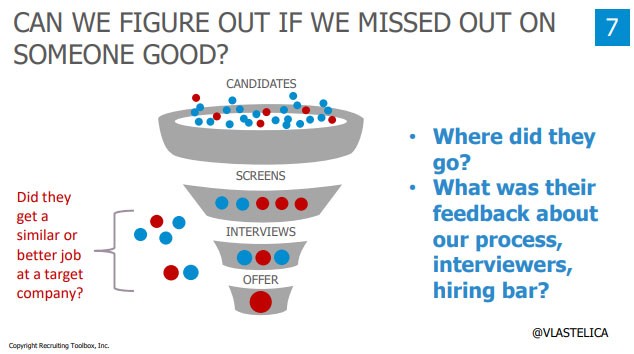
“Maybe those [competitors] have a low bar and a [bad] process, so maybe this person wasn’t good,” he says. “That's a possibility. Maybe it wasn't a false negative. But I would say some of the time it is — and we need to call that out.”
Another way to reduce false negatives is to ensure your hiring managers and interviewers are truly aligned on what you’re looking for. Some requirements, like seniority level, can be highly subjective, so you need to make sure every person involved in the decision-making process is on the same page.
You can also probe deeper when interviewers give an ill-defined reason for turning a candidate down — like feeling concerned that the person won’t hit the ground running. In that instance, you could ask them if the candidate is trainable, how long it would take them to train, and what the hiring manager considers a reasonable ramp-up time.
“No one hits the ground running,” John says. “Let's not let one interviewer who has their own perception that you have to hit the ground running ruin the whole thing and create a false negative.”
8. Designate one person to hold others accountable for making great hiring decisions
For John, a crucial aspect of becoming a strategic talent advisor is putting an accountability mechanism in place to ensure the right hiring decisions are being made. Without one, all your other efforts could be in vain.
“If you don't have an accountability mechanism,” John says, “you are not going to hire great people. What a waste of money to train everyone in behavioral interviewing or whatever, and then end up with no accountability in the room when we're making [hiring] decisions.”
That doesn’t mean that you have to be the one personally holding others accountable — after all, you can’t be everywhere at once. But if you have concerns that poor decisions are being made, you may want to ensure that there’s always one interviewer who is consciously upholding the high standards you expect in the interview process.
Earlier in John’s career, he co-built and co-led a program that designated certain interviewers as “Bar Raisers” because their job was to keep standards high and to always push for better and better — both for the interviewing process and the talent hired.
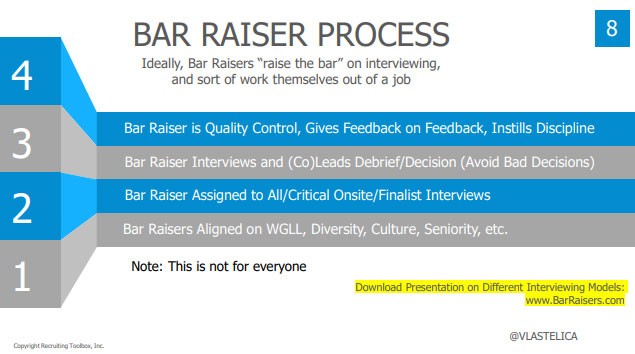
“[They] don't report to the hiring manager,” he explains, “but have some backbone and are able to push back if they think a bad decision is being made…. They instill discipline in our interview process and they hold us accountable to what we mean by our core competencies or the behaviors we look for in [new hires].”
If you want to learn more about this concept, you can watch John’s webinar about how companies like Amazon, Microsoft, and Facebook keep their bars high.
9. Create a true partnership between recruiters and hiring managers to foster a culture of recruiting
At the end of the day, there’s only so much you can do as a talent professional to bring great people into your organization. After all, the hiring managers also play a huge, critical role today.
“When I think about who gets top talent," John says, “top talent goes to engaged hiring managers.”
That’s why one of the most strategic things you can do as a talent advisor is to foster a culture of recruiting. And that’s only possible if your recruiters and hiring managers have a true partnership — rather than a relationship that’s predicated on giving and taking orders.
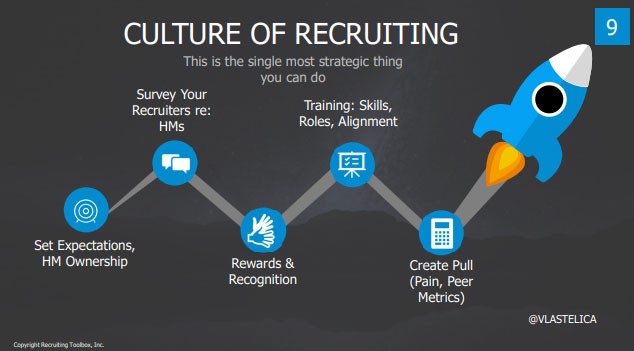
“One of the things we need to do is … to set expectations for what great hiring managers look like,” John says. “And that includes going into orientation, pushing yourself into staff meetings, [and] talking to VPs about how you're going to build hiring manager expectations into performance reviews.”
Another step you can take is rating hiring managers on things like responsiveness, pre-funnel work, and how well they led the interview process. They likely already fill out a survey and rate their recruiters after a req is filled, but feedback needs to become a two-way street. So, you should survey your recruiters on hiring manager performance, as well. And when they do a great job, you need to recognize that — or they won’t feel motivated to do it again.
Lastly, you need to learn how to speak what John calls your hiring managers’ “love language.” Leave the HR-speak at the door and focus instead on the things they care about and are being measured on: speed and quality.
“When you're speaking in those terms, you're absolutely, absolutely going to get more engagement from them,” John says. “I'm not guaranteeing that they're going to do everything you ask them to do — but they're going to lean in a little more.”
Final thoughts: Becoming a strategic advisor involves running toward the big problems, not away from them
In order to become a strategic talent advisor, you can’t be afraid of diving in headfirst when you spot a challenging opportunity. But you also have to know how to pick your battles.
“If you take on the big, scary problems, you will grow in your career much faster than your colleagues will,”John says. “When you see a problem, when you see a pain point, when you see something that's broken… If it's tied to speed, quality, and diversity, you run to it. If it's not, you run the other direction, because it's not going to help the business.”
For more tips and insights on how to become more strategic, download the complete presentation slide deck and watch John’s full talk from Talent Connect 2019 below.
Interested in elevating your team of recruiters to strategic talent advisors? Learn more about our Talent Advisor Training.
To receive blog posts like this one straight in your inbox, subscribe to the blog newsletter.
